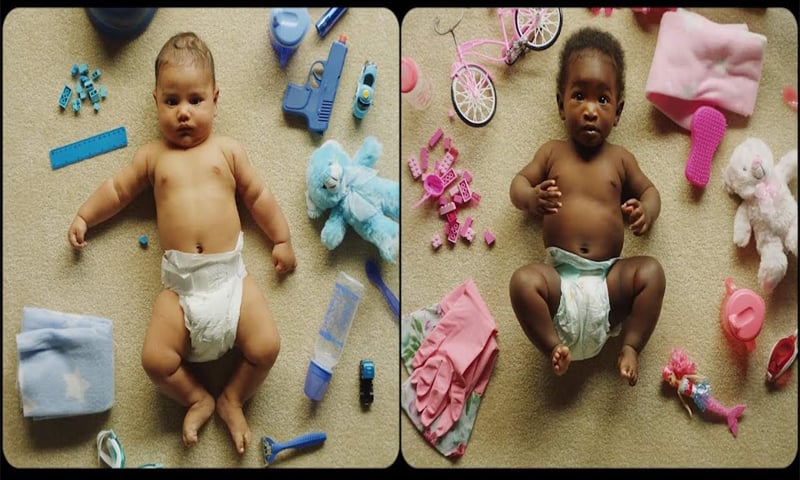Pink or Blue
Pink or Blue
Little Blue climbs a tree: strong boy
Little Pink climbs a tree: tomboy
Rings the haunting words of Hollie McNish in a short called Pink or Blue. The commentary on how we stereotype between a male and female child is a global debate. From #MeToo to equal pay, to underrepresentation in STEM fields and opportunities for women in tech, they are the thorns by your side that you have learned to live with.
Yet it started out as an advertising debate. Let’s go to a brilliant article in co-design that takes us back in time:
It is June 1918. According to an article in the trade publication Earnshaw’s Infants’ Department: “the generally accepted rule is pink for the boys and blue for the girls. The reason is that pink, being a more decided and stronger colour, is more suitable for the boy, while blue, which is more delicate and dainty, is prettier for the girl.” Other sources said blue was flattering for blonds, pink for brunettes; blue was for blue-eyed babies, pink for brown-eyed babies.
It wasn’t until the 1940s that retailers and manufacturers decided on pink for girls and blue for boys.
You have read this before, and you have ignored this before. Aurora has carried some fantastic pieces on women in the advertising industry both on camera and behind it. So, I would like to change the lens. You know how women are portrayed. They are the worried mom, the insecure daughter-in-law, the nagging wife, the selfless nurturer (Nido/Dalda), the sex object or the unattainable goddess (most lawn brands), the juggler ( most detergent ads) or the token presence (most bank ads).
What I would like to see as a consumer and an advertiser are these roles for men.
The helper
Won’t it be nice if we see the man of the house doing the dishes with mom or picking up after kids rather than sitting on a sofa reading his newspaper? You may argue that this is not true in our society; well so is the decked up, freshly blow-dried babe in the kitchen slaving over the stove. As advertisers, we shape culture. We teach people how to twist the cookie before dipping it in milk. Let’s use the power to showcase men who are man enough to wear an apron.
The naysayer
The CEO who created a nursery in the office to support the work-life balance of the female staff, the father who stood by his daughter when she decides to write her own destiny. Behind every successful woman is a man who is not scared to stand in her shadow. Show me these heroes, please. Show the men of the world that they can be these heroes.
The sidekick
The clichéd scene of the girl turning to the hero saying, “What will we do now?” The proverbial damsel in distress. Let’s reverse that. Show our girls that they can lead and there is no shame in leading. She is the hero and the man is Robin.
Globally, many initiatives are aiming to arrive at the same point that I am struggling to make here. One of the biggest one is #Unstereotype by the UN, an initiative that aims to stop showing women in a stereotypical fashion. Unilever was one of the first companies to join the initiative. Remember that Unilever’s Axe/Lynx brand is known for objectifying women. For a brand that uses the suggestive line “get clean to get dirty” on its packaging, they will have to rethink a lot of its messaging and personality to follow the pledge of #Unstereotype. This will be an interesting one to watch. Today more and more brands are joining the #Unstereotype alliance which includes names such as P&G, WPP, Diageo, Google and Facebook.
The UK’s Advertising Standards Authority (ASA) vowed to take a tougher line on gender stereotypes in ads after the launch of #Unstereotype. ASA argues that that gender stereotype is harmful to society. Ads with over sexualisation or unrealistic body images of women will be banned. The watchdog is also pledging to eliminate ads that show women left with the sole responsibility of cleaning up a mess created by her family. Other campaigns like ‘Women Not Objects’ and ‘#SeeHer’ are trying to battle issues to women’s portrayal in media.
To sum it all up, we are doing a huge disservice to our children by teaching them stereotypes like pink is for girls and blue is for boys. Let’s teach our boys that boys will not be boys and they also have a code of conduct. Teach your son to do his laundry and make the tea for the guests and teach your daughter that she can climb as many trees or mountains that she desires.
Atiya Zaidi is Executive Creative Director, Synergy Dentsu. atiya.zaidi@synergydentsu.com




Comments (21) Closed